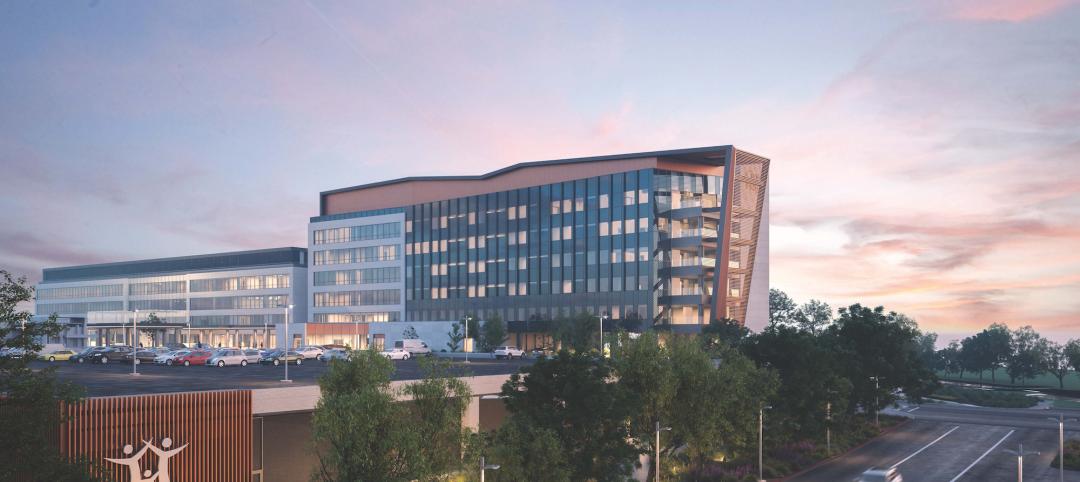The United States is on track to end this year with its highest level of construction put in place since 2008, a total that, if achieved, would represent nearly 7% of the country’s GDP.
However, construction has slowed of late, according to FMI Corporation, the management and investment consultant. In its Q2 Construction Outlook, FMI estimates construction in place this year would rise 5% to $1.012 trillion. In the first quarter, FMI had projected an 8% annualized gain.
FMI estimates the nonresidential building portion of total construction to expand by 7.6% to $407.2 billion in 2015, and to keep growing through 2019, when it should reach $510.2 billion. However, with housing also expected to recover strongly during this period, nonresidential building’s share of total construction put in place would fall in 2019 to 39.1%, from 40.2% in 2015.

Construction spending in general “continues to build on the rapid growth experienced in the industry last year,” observes Chris Daum, FMI’s senior managing director and president of Investment Banking. FMI’s latest report looks at 17 sectors. Here are some highlights:
• Don’t anticipate much from the two big-ticket sectors, Healthcare and Education, says FMI.
Even with 2.5 million students expected to enroll over the next four year, FMI doesn’t see Education growing in 2015. “One of the biggest hurdles to new construction continues to be state and local budgets,” it writes, adding that there is likely to be “significantly less” state funding for K-12 schools.”
Healthcare should fare a little better, growing by 2% in 2015, and 4% in 2016 to $41 billion. But a “difficult funding environment,” along with changes to construction delivery methods, poses challenges. One trend FMI identifies is toward rebuilding existing facilities using modern hospital design and allow for greater use of technology.
• Manufacturing: After a double-digit gain in 2014, FMI expects manufacturing construction to increase by 17% this year, and then slow to an 8% increase in 2016. It cautions that manufacturing capital construction is highly cyclical when markets reach a state of overcapacity, as some petrochemical products are expected to do in the next few years after a spate of building.
• Amusement/recreation: This section grew by 7% in 2014, and should top that at 9% in 2015. Several major sports stadiums are under construction, and a number of smaller towns and colleges are improving their sports facilities. States also continue to welcome gaming in hopes of increasing their tax bases. A new mixed-use development model combines multiple entertainment venues and shopping into an overall plan.
• Lodging: This sector will be a bright spot, growing by 19% in 2015, and by 12% in 2016, before slowing to 7% in 2019. To buttress its projections, FMI quotes from Lodging Econometrics’ May 2015 reports, which notes that there are 3,885 projects with 488,230 rooms in the construction pipeline, “with the last three quarters posting Year-Over-Year gains of 20% or greater.”
• Office: This sector is benefiting from improving employment levels, and should see 11% growth in 2015, albeit a bit slower than the 19% it hit in 2014.
• Commercial: Capturing what’s going on in retail construction, this sector is expected to grow by 13% to $69 billion this year, but be flat in 2016. “Consumers remain relatively confident about the economy, but they are also remaining conservative in their discretionary spending, at least until wage recovery improves,” FMI writes.
• Religious: What growth there is will likely be in renovation, as new congregations move into vacated retail space or reoccupy church buildings abandoned by other faiths. FMI thinks this sector could be flatlining, and quotes statistics from Pew Research Center that show the percentage of adults (ages 18 and older) who describe themselves as Christians dropping by nearly eight percentage points in just seven years through 2014. Over that same period, the percentage of Americans who are religiously unaffiliated jumped by more than six points, to 22.8%
• Transportation: After registering 5% growth in 2014, transportation is expected to add 7% for 2015 to $44.7 billion. But this sector remains heavily dependent on government support that is never a certainty.
Related Stories
Giants 400 | Oct 6, 2022
Top 90 Hospital Facility Contractors + CM Firms for 2022
Turner Construction, Brasfield & Gorrie, DPR Construction, and JE Dunn top the ranking of the nation's largest hospital facility contractors and construction management (CM) firms for 2022, as reported in Building Design+Construction's 2022 Giants 400 Report.
Giants 400 | Oct 6, 2022
Top 115 Healthcare Sector Contractors + CM Firms for 2022
Turner Construction, Brasfield & Gorrie, DPR Construction, and JE Dunn Construction top the ranking of the nation's largest healthcare sector contractors and construction management (CM) firms for 2022, as reported in Building Design+Construction's 2022 Giants 400 Report. Note: This ranking factors all healthcare sector work, including hospitals, outpatient facilities, and medical office buildings.
Giants 400 | Oct 6, 2022
Top 90 Healthcare Sector Engineering + EA Firms for 2022
Jacobs, AECOM, WSP, and IMEG Corp. head the ranking of the nation's largest healthcare sector engineering and engineering/architecture (EA) firms for 2022, as reported in Building Design+Construction's 2022 Giants 400 Report. Note: This ranking factors all healthcare sector work, including hospitals, outpatient facilities, and medical office buildings.
Giants 400 | Oct 6, 2022
Top 170 Healthcare Sector Architecture + AE Firms for 2022
HDR, CannonDesign, HKS, and Stantec top the ranking of the nation's largest healthcare sector architecture and architecture/engineering (AE) firms for 2022, as reported in Building Design+Construction's 2022 Giants 400 Report. Note: This ranking factors all healthcare sector work, including hospitals, outpatient facilities, and medical office buildings.
Designers / Specifiers / Landscape Architects | Oct 6, 2022
DAHLIN announces acquisition of Design Line Interiors
DAHLIN Architecture | Planning | Interiors announced today that it is expanding its interiors capabilities with the acquisition of Del Mar, California-based Design Line Interiors.
Contractors | Oct 6, 2022
Modular construction gets boost from impacts of the pandemic
The impact of the Covid pandemic on the construction industry appears to be fueling demand for modular construction methods, especially in the western U.S. and Canada.
Webinar | Oct 6, 2022
Register today! Live webinar: The future of 3D + 360° construction progress management
Learn about the value of digital site documentation and progress monitoring, how reality capture is used for site documentation, and the value of both 3D scans and 360 photos. This live webinar will take place Thursday, October 20 at 2 ET/ 1 CT.
Laboratories | Oct 5, 2022
Bigger is better for a maturing life sciences sector
CRB's latest report predicts more diversification and vertical integration in research and production.
Multifamily Housing | Oct 5, 2022
Co-living spaces, wellness-minded designs among innovations in multifamily housing
The booming multifamily sector shows no signs of a significant slowdown heading into 2023. Here is a round up of Giants 400 firms that are driving innovation in this sector.
Contractors | Oct 5, 2022
Materials shortages, cost spikes throwing Design-Bid-Build process out of whack
The traditional Design-Bid-Build delivery process is under considerable stress this year as materials shortages and cost spikes are upending usual practices, according to a new report from JLL.

















